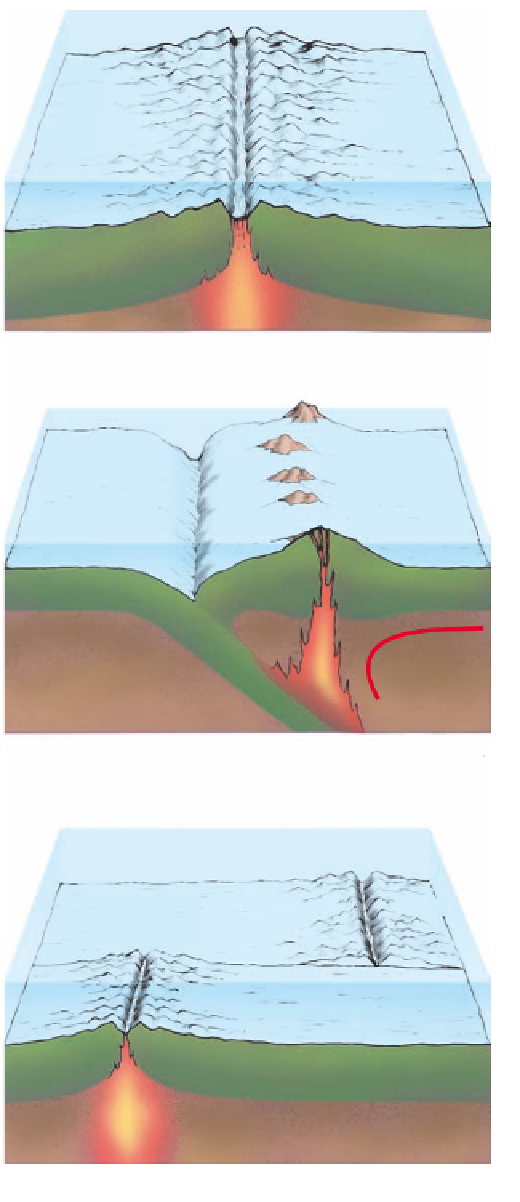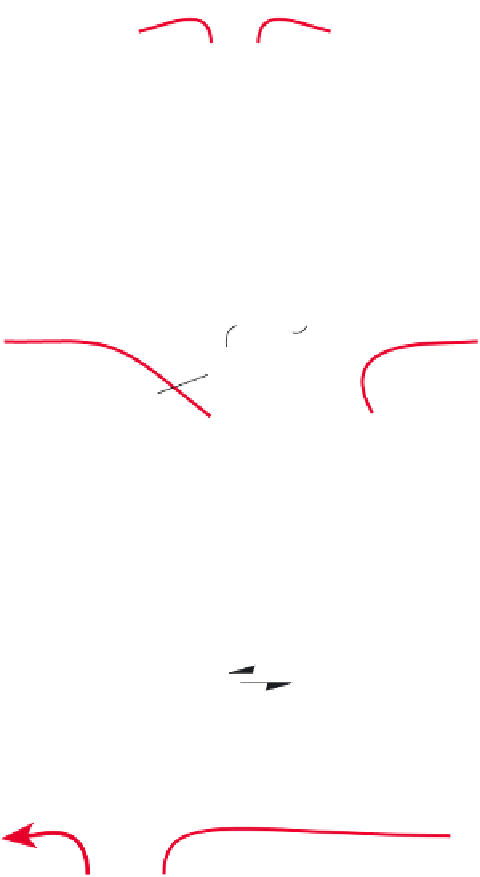Environmental Engineering Reference
In-Depth Information
A second process is
chemical weathering,
in which
one or more chemical reactions decompose a mass of
rock. Most chemical weathering involves a reaction of
rock material with oxygen, carbon dioxide, and mois-
ture in the atmosphere and on the ground.
A third process is
biological weathering,
the conver-
sion of rock or minerals into smaller particles through
the action of living things. For example, lichens pro-
duce acids that can chemically weather rocks. Roots
growing into and rubbing against rock can also physi-
cally break it into small pieces.
Lithosphere
Asthenosphere
Oceanic ridge at a divergent plate boundary
12-3 MINERALS, ROCKS,
AND THE ROCK CYCLE
Trench
Volcanic island arc
Science: Minerals and Rocks
The earth's crust consists of solid inorganic elements
and compounds called minerals and masses of one or
more minerals called rock.
The earth's crust, which continues to form in various
places, is composed of minerals and rocks. It is the
source of almost all the nonrenewable resources we
use: fossil fuels, metallic minerals, and nonmetallic
minerals. It is also the source of soil and the elements
that make up your body.
A
mineral
is an element or inorganic compound
that occurs naturally and is solid with a regular inter-
nal crystalline structure. A few minerals consist of a
single element, such as gold, silver, diamond (carbon),
and sulfur. Most of the more than 2,000 identified min-
erals, however, occur as inorganic compounds formed
by various combinations of elements. Examples in-
clude salt, mica, and quartz.
Rock
is a solid combination of one or more miner-
als that is part of the earth's crust. Some kinds of rock,
such as limestone (calcium carbonate, or CaCO
3
) and
quartzite (silicon dioxide, or SiO
2
), contain only one
mineral, but most rocks consist of two or more minerals.
Lithosphere
Rising
magma
Asthenosphere
Subduction
zone
Trench and volcanic island arc at a convergent
plate boundary
Fracture zone
Transform
fault
Lithosphere
Science: Rock Types and the Rock Cycle
The earth's crust contains igneous, sedimentary,
and metamorphic rocks that are recycled by the rock
cycle.
Based on the way it forms, rock is placed in three
broad classes: igneous, sedimentary, or metamorphic.
Igneous rock
forms below or on the earth's surface
when molten rock (magma) wells up from the earth's
upper mantle or deep crust, cools, and hardens. Exam-
ples include
granite
(formed underground) and
lava
rock
(formed aboveground when molten lava cools and
hardens). Although often covered by sedimentary
rocks or soil, igneous rocks form the bulk of the earth's
crust. They also are the main source of many nonfuel
mineral resources.
Asthenosphere
Transform fault connecting two divergent plate boundaries
Active Figure 12-5
Natural capital:
types of boundaries be-
tween the earth's lithospheric plates. All three types occur both
in oceans and on continents.
See an animation based on this
figure and take a short quiz on the concept.
collects in pores and cracks of rock, expands upon
freezing, and splits off pieces of the rock. Frost wedg-
ing causes most of the potholes that plague roads and
streets.

















